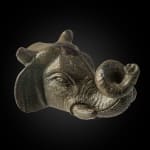-
Opere
ELEPHANT, Roman Empire, 2nd Century A.D.
bronze2.3 x 5 cm
1 x 2 inFurther images
This beautiful cast bronze elephant head is a protome, which in ancient art was a decorative element consisting of a head - sometimes with part of the bust - of...This beautiful cast bronze elephant head is a protome, which in ancient art was a decorative element consisting of a head - sometimes with part of the bust - of a human, animal, or fantastical figure. The present artwork was in fact probably part of a furniture piece, such as a couch or chair. Its features are extremely realistic, and resemble the large elephant head couch attachment once in the James Loeb collection, donated to the Staatliche Antikensammlungen in Munich, acc. no. 50.
In classical times, animals often carried supernatural powers, or conveyed certain characters in the collective imagination. Elephants were symbols of strength, power and ferocity. They were extensively depicted in Roman households, as a representation of the supremacy of the Roman Empire.
Besides exhibiting the skillfulness of ancient craftsmen, this sculpture is a testament to one of the largest ancient animal sculpture collections in modern times, once owned by Leo Mildenberg.
Leo Mildenberg was the Vice President of the oldest bank in Switzerland, the Bank Leu, in Zurich, founded in 1755. He was also responsible for the exhibition and cataloguing of ancient coins, owned by the Bank. Dr. Mildenberg developed an interest in ancient history, with a particular appreciation for small, precisely carved bronze artworks.
This small but powerful bronze sculpture, was displayed in a temporary exhibition at the Cleveland Museum in 1981, titled “Animals in Ancient Art from the Leo Mildenberg Collection”, and the press release stated: “Leo Mildenberg, a director of the Bank Leu in Zurich, Switzerland, and one of the world’s foremost authorities on ancient coins, has over the past thirty years assembled an extraordinary collection of animal figures from ancient Near Eastern, Egyptian and classical cultures.”Provenance
Leo Mildenberg (1913-2001) collection, Zurich
English Private Collection
Private Collection, Florida, USA
Esposizioni
Cleveland Museum, Animals in Ancient Art from Leo Mildenberg Collection, 21st October-29th November 1981Pubblicazioni
A.S. Walker, Animals in Ancient Art from the Leo Mildenberg Collection, Part III,
Mainz am Rhein, 1996, no. 173
P.E. Mottahedeh, Out of Noah’s Ark, Animals in Ancient Art from the Leo
Mildenberg Collection, Bible Lands Museum, Jerusalem, 1997, no. 98
Art Loss Register ref. S00220469
25di 27












